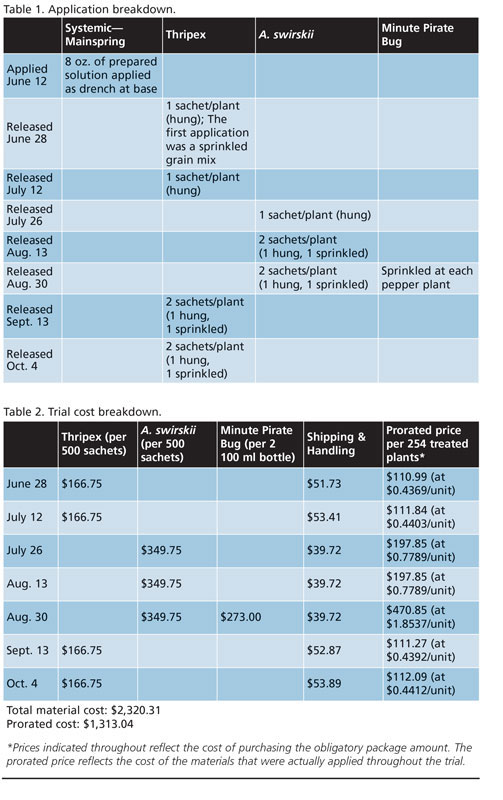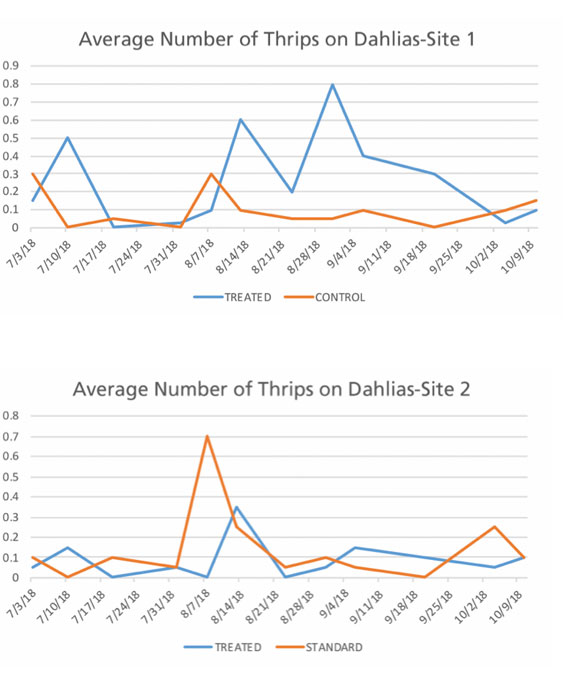3/1/2019
IPM & Insect Pests of Dahlias
Stanton Gill, Nancy Rechcigl, Suzanne Klick & Rachel Ross
The beauty of the dahlia flower is desirable and spectacular. Forms and shapes of flower petal clusters are brightly colored from early summer through late fall. What is not to love about dahlias?
Unfortunately, humans aren’t the only ones that desire the luscious flowers and vegetative parts of the dahlias. Thrips, aphid species, Tetranychid mites, corn borer and cucumber beetle are just a few of the pests that prefer not to share the dahlia flowers with you.
 In the spring of 2018, Nick Weber of the Maryland Dahlia Society asked us to develop an IPM approach for dealing with insect and mite pests of dahlia plantings. Over the years, we’ve developed many biological control programs for greenhouses crops with good success rates. We decided that a combination of systemic chemical and biological control releases could work well.
In the spring of 2018, Nick Weber of the Maryland Dahlia Society asked us to develop an IPM approach for dealing with insect and mite pests of dahlia plantings. Over the years, we’ve developed many biological control programs for greenhouses crops with good success rates. We decided that a combination of systemic chemical and biological control releases could work well.
Working closely with Nancy Rechcigl of Syngenta, Bell Nursery of Burtonsville, Maryland, Jan Meneley of AgBio, and Koppert Company, we analyzed several products before settling on use of Mainspring drenches applied twice during the year combined with predacious mite releases, use of banker plants, use of predacious insects, and pheromone and food-baited sticky traps.
First, the chemical treatment
The first step was obtaining seed from Ball Horticultural of an ornamental pepper called Purple Flash. (We used Purple Flash since it had a characteristic of continual blooming during the growing season.) These pepper plants would be utilized as a banker plant to produce pollen and nectar to feed a predacious bug called Orius used to control thrips.
The seed was turned over to Bell Nursery in March to start growing the pepper plants. Pepper plants are slow to get going and we needed them in bloom by mid-summer, so three months needed to be allotted to have them in bloom for our Maryland growing season.
The dahlia tubers were planted at two sites—one in Brookeville and the other in Damascus. At both sites, the tubers were planted in late May of 2018.
We had treated blocks and untreated blocks of plants. On the treated blocks, we made a soil drench of Mainspring at a rate of 8 oz./100 gal. of water. Each plant was drenched at the base with 8 oz. (237 mL or .24 L) of prepared liquid solution.
Mainspring GNL is a suspension concentrate (SC) formulation containing 1.67 lbs. of cyantraniliprole per gallon. Cyantraniliprole belongs to the anthranilic diamide chemical class, introducing a new class of chemistry in IRAC Group 28 for ornamental insect control. Mainspring quickly stops insect feeding after ingestion, and it’s compatible with many beneficial insects and mites.
This Mainspring application provided protection from aphids and thrips feeding on foliage and dahlia stems. The two common species of aphids found on dahlias are green peach aphid and melon aphid. Plants were monitored on a weekly basis and no aphids were detected in the first 12 weeks of growth. Also, no thrips populations were found on treated plants.

Next, biocontrols
We obtained Amblyseius cucumeris mites, a predatory mite that feeds on thrips nymphs. This species of thrips predatory mite has been used for prevention, control and maintenance of various thrips species with fairly good success in greenhouse operations. The mites use sucking mouth parts to pierce and ingest contents of their prey. We purchased the mites under the name THRIPEX-PLUS from Koppert Biological Systems.
For the first release, we used mites in a loose grain container mix. The grain was sprinkled on foliage and flowers of dahlias. The growers found the grain mix undesirable in appearance, so we switched to using A. cucumeris in small sachets. Each paper sachet with hook contains 1,000 predatory mites and grain mites (all stages) mixed with bran.
Amblyseius cucumeris performs best in temperatures under 90F (32C). Normally in Maryland, temperatures reach above these temperatures in July and August, so we switched to the predacious mite Amblyseius swirskii in sachets, which performs better at higher temperatures. This mite is about two to three times the cost of A. cucumeris.
For Orius, the materials used were two 100 mL bottles containing 1,000 minute pirate bugs. Pirate bugs were sprinkled on each Purple Flash Pepper plant at both sites on August 30, 2018.
Summary
Mainspring (cyantraniliprole) at 8 oz./100 gal. of water applied as a soil drench was excellent in controlling the aphids on the treated plants and provided control for the whole growing season. The Mainspring drench applications didn’t impact predator releases of the predacious mites or Orius released during our study.
The season of 2018 had records amount of rain both in frequency and abundance. This generally suppressed both Tetranychid mite (twospotted spider mites) and thrips activity in the growing season. The dahlias in the biological control/systemic chemical control area had a greater number of blooms and thus had slightly higher populations of thrips in blooms. The thrips populations remained low on the conventionally treated plants, and the plants that were treated with chemical and biological control.
The banker plants did well and the Orius populations, after the initial release, remained active throughout the season. We switched from releasing Amblysieus cucumeris in mid-summer to releasing A. swirskii. A. swirskii performs better in higher temperatures and we expected normal high temperatures July through September.
We encountered a pest during the study that we hadn’t anticipated—spotted cucumber beetle. Working with Jan Meneley of AgBio, we evaluated a yellow sticky card baited with pheromone and essence of cucumber extract. The traps worked well in catching and preventing feeding damage to the petal rays of the dahlias.
The quality of the plants and flowers were equally high on the conventional and biological/systemic-chemical treated plants.
We would like to conduct a second year of this project, hopefully, with a less rainy season. We’ll try reducing the number of biological releases to reduce the cost per plant. GT
Stanton Gill (Sgill@umd.edu) is Extension Specialist in IPM for Greenhouses and Nursery at the Central Maryland Research and Education Center for the University of Maryland Extension, and Professor of Landscape Technology at Montgomery College, Landscape Technology. Nancy Rechcigl is Technical Services Manager for ornamentals for Syngenta. Suzanne Klick (sklick@umd.edu) is Lead Technician at the Central Maryland Research and Education Center for the University of Maryland. Rachel Ross is a Student Intern at the University of Maryland.